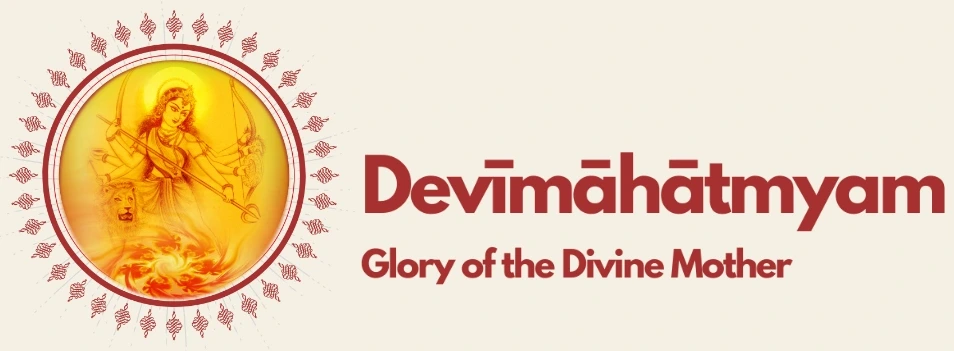The Mode of Recital
The Sādhaka should recite in the following order: He should first recite Kavaca, Argala, Kīlaka, do the Nyāsas and Japa of the Mantra Navākṣarī, recite Rātri Sūkta and then the text of three episodes containing 13 chapters. He follows up with Devi Sūkta, the o japa f Navākṣarī with the Nyāsas and then with the three secrets, Rahasya traya. He does again the Utkīlana Mantra and finishes by dedicating the whole act of recital to the Goddess and recites the Aparadha Kṣamārpaṇa, prayer craving pardon for all the faults and mistakes he might have committed.
The first episode is the first chapter of the text and deals with the destruction of the Asuras, Madhu and Kaitabha. The deity is Mahākālī, predominating in the guṇa tamas. The seer is Brahmā, the metre is Gāyatrī, the force Nanda and the seed Raktadantikā. The principle, tattva is that of Agni, fire and the form represented is ṚgVeda. The purpose is the pursuit of Dharma.
The second episode consists of the second, third and fourth chapters and deals with the destruction of Mahiṣāsura. The deity is Mahālakṣmī, pre dominating in the guṇa rajas. The seer is Viṣnu, the metre is Uṣṇik, the force Śākambhari and the seed Durgā. The tattva is that of Vāyu, wind, and the form represented is Yajurveda. The purpose is the pursuit of Artha.
The third episode comprises the nest of the chapters of the text and in it are portrayed the deeds of the Devī in vanquishing Śumbha, Niśumbha and their hosts. The deity is Mahāsarasvatī, predominating in the guṇa satva. The seer is Śiva, the metre is Anuṣṭub, the force Bhīma and the seed Bhrāmarā. The tattwa is that of Surya, the Sun, and the form represented is Sāma Veda. The purpose is the pursuit of Kāma.
There are certain rules to be followed in the recital. The recital should not be stopped in the middle of a chapter. If by mistake there happens a break in the middle, the chapter has to be read again from the beginning. The reading should be in the proper order and not haphazard. All unnecessary movements like shaking the head etc. should be avoided. The Pranic force that is to be carefully conserved and preserved leaks out of the body by these movements. The reading should never be done mentally. There should be audible recitation.¹ And it should not be done fast, in a hurry. The reading should be in a slow even manner, śanaistu japyamāne.
(1. यावन्न पूर्यते तावन्न विरमेत् पठन्। यदि प्रमादादध्याये विरामो भवति प्रिये॥
पुनरध्यायमारभ्य पठेत् सर्वै मुहुर्मुहुः। अनुक्रमात् पठेदेव शिरःकम्पादिकं त्यजेत्।
न मानसं पठेत् स्तोत्रं वाचिकं तु प्रशस्यते॥)
It is very commendable to read all the three episodes at one sitting. If it is not possible, the middle chapter alone can be read, ekena vā madhyamena, and not any one of the other two, naikena itarayoḥ. It is not right to read a portion of the episode and leave it half-finished: then it will be a chink in the armour, an opening for the hostile forces to attack. Caritārdham tu na japet, japan chidram avāpnuyāt.
But yet there is a practice followed in Kerala, finishing the text of three episodes in seven days reading. And this is continued week after week. The first chapter is read on the first day, the second and third chapters on the second day, the fourth chapter on the third day, the fifth, sixth, seventh and eighth chapters on the fourth day, the ninth and tenth on the fifth day, the eleventh on the sixth day and the twelfth and thirteenth chapters on the seventh day.¹ According to this practice, an episode is not finished in a single day.
Those who cannot recite themselves can hear with devotion a recital by another and derive benefit. Special modes of recital are dealt with in the chapter on Prayoga.
1. This is remembered by a mnemonic pāṭho’yaṁ dvi prakāraḥ. The letters is this, as per the usual Kaṭapayṭdi saṁkhyā stand for 1,2,1,4,2,1,2 denoting the number of chapters to be read each day of the week.

